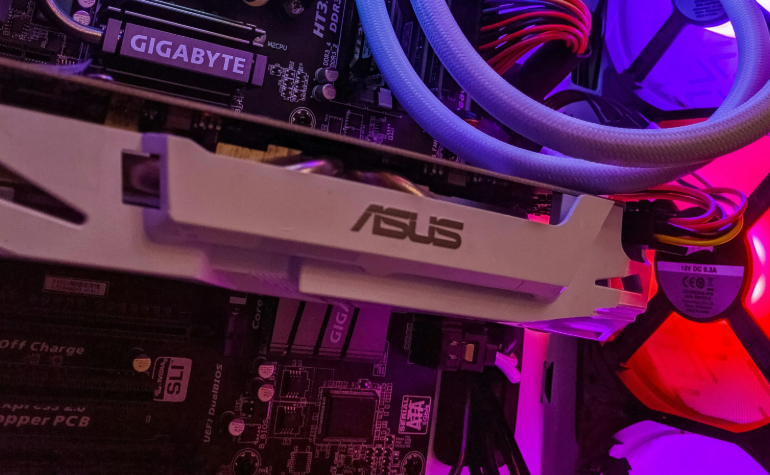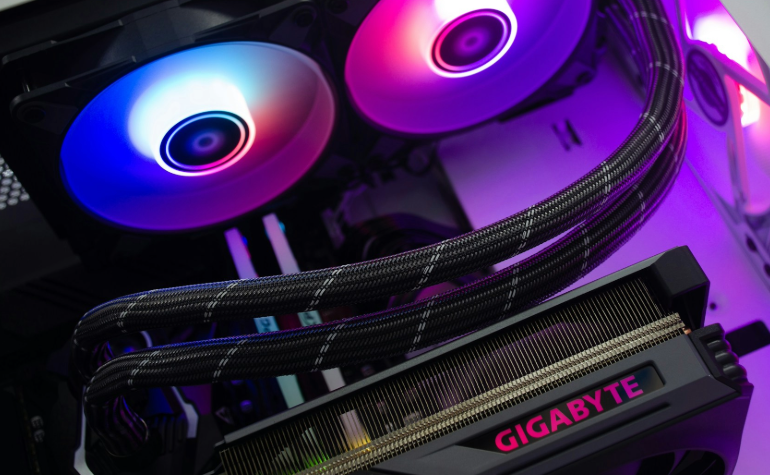Gigabyte P67A UD7 vs ASUS Maximus IV: Titan Clash
Explore the ultimate battle between Gigabyte P67A UD7 and ASUS Maximus IV Extreme. Who will reign supreme in this titan clash?

In the world of high-performance computing, choosing the right motherboard can make all the difference. The Gigabyte P67A UD7 and ASUS Maximus IV Extreme stand out as top contenders, each boasting advanced features designed to enhance your gaming and computing experience. This article delves into a detailed comparison of these two powerhouse motherboards, pitting them against each other in what can only be described as a Titan Clash. From their processing capabilities to their aesthetic appeal, we explore which board might be the best fit for your system.
The Gigabyte P67A UD7 is renowned for its robust build quality and excellent overclocking potential, making it a favorite among gamers and performance enthusiasts alike. On the other hand, the ASUS Maximus IV Extreme is celebrated for its cutting-edge technology and superior customization options, particularly appealing to those who demand top-tier performance and control. By comparing these two giants, we aim to provide a clear picture of what each can offer, helping you make a well-informed decision on which motherboard will anchor your next dream build.

Key Features Comparison
When selecting a motherboard, the differences in features can significantly impact system performance and compatibility. This section dives into a detailed comparison of the Gigabyte P67A UD7 and ASUS Maximus IV Extreme, focusing on their processor support, memory capabilities, and expansion options. Each aspect will be critically analyzed to highlight how these motherboards cater to different user needs and preferences.
Processor Support and Compatibility
The Gigabyte P67A UD7 supports the Intel P67 chipset, compatible with 2nd generation Intel Core processors. This allows users to leverage Intel's Turbo Boost Technology 2.0 for enhanced performance. Key advantages include support for Intel K-series unlocked CPUs, which is ideal for overclockers.
In contrast, the ASUS Maximus IV Extreme is designed around the same chipset but stands out with its ROG-exclusive features. ROG CPU-Z and Extreme Engine Digi+ II are notable, providing enhanced CPU performance tuning and precise power control, which are crucial for achieving maximum overclocking.
Memory Support and Performance
Memory compatibility is another critical factor. The Gigabyte P67A UD7 supports dual-channel DDR3 memory, offering speeds up to 2133 MHz through overclocking. This motherboard excels in stable memory overclocking, thanks to its robust voltage regulation and cooling features.
The ASUS Maximus IV Extreme also supports dual-channel DDR3, but it pushes further with support for higher frequencies natively up to 2200 MHz. Mem TweakIt and ROG Connect are standout features, allowing users to tweak memory settings in real-time via a laptop or smartphone, enhancing the flexibility and performance tuning potential.
Expansion Slots and Connectivity
Both motherboards provide a wealth of expansion slots, but with some differences in layout and additional features. The Gigabyte P67A UD7 offers two PCI Express x16 slots capable of running at full x16 bandwidth, ideal for high-end gaming setups or extensive multi-GPU configurations.
The ASUS Maximus IV Extreme expands on this with three PCI Express x16 slots, supporting triple SLI or CrossFireX setups, providing superior flexibility for gamers and professionals. ROG Connect technology also allows for on-the-fly tuning of these configurations, a unique feature that sets it apart in terms of connectivity and control.
Taking these features into account, it's clear that both motherboards are designed to meet the demands of serious gamers and performance users. The choice between Gigabyte P67A UD7 and ASUS Maximus IV Extreme ultimately depends on specific user requirements such as overclocking needs, memory performance, and expansion capabilities. Each board has its strengths, and your decision should align with your priorities in system building and future-proofing your computing environment.
Design and Aesthetics
The design and aesthetics of a motherboard can be as crucial as its performance, especially for users who value a visually appealing setup alongside robust functionality. This section explores the physical build quality and visual design of the Gigabyte P67A UD7 and ASUS Maximus IV Extreme, providing insights into how these aspects enhance user experience and system durability.
Build Quality and Durability
The Gigabyte P67A UD7 is renowned for its sturdy construction. Ultra Durable 3 technology is a standout feature, incorporating 2 ounces of copper for both the Power and Ground layers, boosting the system’s thermal efficiency and overall stability. Japanese solid capacitors and Ferrite core chokes ensure longevity and reliability, particularly under high-stress conditions like overclocking and extended gaming sessions.
The ASUS Maximus IV Extreme matches its competitor with equally high standards of durability. It features ROG Extreme OC kit, which includes premium components such as 10K Black Metallic capacitors that not only last long but also withstand varied environmental conditions. This motherboard is built to endure, making it a reliable choice for enthusiasts who demand endurance alongside performance.
Visual Appeal
Visual appeal is another domain where both motherboards shine, albeit catering to different tastes. The Gigabyte P67A UD7 boasts a sleek black PCB with subtle blue accents that give it a classic, understated look. This design suits a variety of case styles, particularly those with a window where the motherboard is a central visual element.
On the other hand, the ASUS Maximus IV Extreme takes a bolder approach with its striking red and black color scheme, iconic of the ROG series. LED lighting adds a dynamic visual element, appealing to gamers and those who prefer a motherboard that makes a visual statement.
Both the Gigabyte P67A UD7 and ASUS Maximus IV Extreme offer more than just powerful specs; they bring a level of design sophistication that can complement any high-end PC build. Whether you prefer the understated elegance of the Gigabyte or the bold, gamer-centric aesthetics of the ASUS, both motherboards serve as a cornerstone for not only a powerful but also an aesthetically pleasing PC setup. Their robust build and appealing designs ensure that they meet the expectations of users who do not want to compromise on style or substance.

Performance Tests
Performance is a critical metric in the battle between the Gigabyte P67A UD7 and ASUS Maximus IV Extreme, especially when it comes to gaming, overclocking, and thermal management. This section puts these motherboards through their paces, examining how each handles demanding tasks and stress tests under various conditions to provide a comprehensive overview of their capabilities.
Gaming Performance
Both motherboards are designed with the gamer in mind, offering features that enhance the gaming experience:
- Gigabyte P67A UD7: Provides robust support for multi-GPU setups through CrossFireX and SLI configurations, ensuring excellent frame rates and smooth performance in graphics-intensive games. Enhanced USB and SATA interfaces also allow for faster data transfers and quicker game loading times.
- ASUS Maximus IV Extreme: Stands out with its ROG GameFirst technology that optimizes network traffic for online gaming, reducing lag and providing a smoother multiplayer experience. Like the Gigabyte, it supports extensive multi-GPU configurations, allowing gamers to maximize their visual settings for ultra-detailed and immersive gameplay.
Overclocking Capabilities
Overclocking is another area where these motherboards shine, each offering unique tools to push system performance beyond standard specifications:
- Gigabyte P67A UD7: Features an advanced 24-phase power design which provides more precise voltage control and significantly enhances the motherboard's ability to sustain heavy loads when overclocked. Dual BIOS settings also help mitigate the risks associated with firmware failures during overclocking.
- ASUS Maximus IV Extreme: Utilizes the ROG Connect technology, which allows users to tweak system parameters in real time from a separate PC or laptop. This is particularly useful for fine-tuning overclock settings without disrupting the primary system operations.
Thermal Management
Effective thermal management is crucial for maintaining system stability and prolonging component life, especially under overclocked conditions:
- Gigabyte P67A UD7: Integrates a comprehensive heatpipe design that effectively dissipates heat away from critical areas like the chipset and voltage regulators. The additional copper layer in the PCB aids in further reducing the thermal load.
- ASUS Maximus IV Extreme: Features an elaborate cooling system with optional fan expansion cards, which provide additional cooling for extreme overclocking scenarios. The board's layout is designed to optimize airflow, ensuring that heat is efficiently expelled from the system.
Evaluating the Gigabyte P67A UD7 and ASUS Maximus IV Extreme across various performance metrics demonstrates their prowess in handling the most demanding computing tasks. Each motherboard brings its strengths to the forefront, catering to different aspects of gaming, overclocking, and thermal management. Whether it's pushing the limits of performance through overclocking or maintaining stability and coolness under load, both models offer the tools necessary for enthusiasts to achieve their desired computing outcomes. Choosing between them will depend largely on specific use cases and personal preferences regarding these key performance factors.
User Experience
The user experience provided by a motherboard encompasses everything from the initial setup to daily operation, including the intuitiveness of its BIOS and the support it offers through software and drivers. Both the Gigabyte P67A UD7 and ASUS Maximus IV Extreme aim to streamline these aspects to enhance overall satisfaction and usability. This section explores how each motherboard performs in terms of user interface and system support, crucial for both novice and experienced users.
BIOS Features and Ease of Use
The BIOS is the cornerstone of motherboard configuration, and both models offer distinct experiences:
- Gigabyte P67A UD7: Features a Dual BIOS system, which not only provides a backup in case of corruption but also offers a user-friendly graphical interface. This UEFI BIOS is straightforward to navigate and makes it easier for less experienced users to perform complex configuration changes.
- ASUS Maximus IV Extreme: Equipped with the ROG UEFI BIOS, known for its extensive customization options tailored specifically for overclockers and enthusiasts. It includes features like:
- GPU.DIMM Post: Easy monitoring of GPU and memory status.
- ROG SSD Secure Erase: Revitalize system speed without compromising data safety.
- OC Profiles: Save and switch between various overclock profiles seamlessly.
Software and Driver Support
Comprehensive software and driver support are essential for maximizing the functionality of motherboards:
- Gigabyte P67A UD7: Provides a suite of software including the EasyTune6 for system tuning and monitoring, and Cloud OC for overclocking via internet-connected devices. The availability of regular driver updates ensures the motherboard remains compatible with the latest hardware and software.
- ASUS Maximus IV Extreme: Offers a richer software ecosystem with exclusive tools like ROG RAMDisk for speeding up game loads, and GameFirst III for optimizing network traffic for gaming. ASUS also maintains an excellent track record for updating its drivers and software, ensuring users have the latest support for new technologies and system stability.
Both the Gigabyte P67A UD7 and ASUS Maximus IV Extreme deliver robust user experiences tailored to different types of users. While Gigabyte provides a reliable and user-friendly approach suitable for a wide range of users, ASUS caters more to power users who prioritize detailed customization and performance tweaks. This distinction in user experience can guide potential buyers in choosing the motherboard that best fits their personal computing habits and needs. The effectiveness of their user interfaces, coupled with their comprehensive software support, makes both motherboards compelling choices, each facilitating a smooth and efficient user experience that can satisfy both general and specialized demands.

Price and Value for Money
Choosing between the Gigabyte P67A UD7 and ASUS Maximus IV Extreme often comes down to not just features and performance, but also their cost and the overall value they offer. This section will examine the pricing strategies of both motherboards, including a look at their warranties and customer support, to determine which provides the better value for money.
Cost Comparison
When it comes to pricing, both motherboards target the upper segment of the market, catering to enthusiasts and gamers who seek top-tier performance:
- Gigabyte P67A UD7: Typically positioned at a slightly lower price point compared to its ASUS counterpart. The more affordable price makes it an attractive option for those who need high-end capabilities without the premium cost.
- ASUS Maximus IV Extreme: Priced at the higher end, reflecting its extensive feature set and the robustness of its overclocking and customization options. For users who require these advanced capabilities, the price can be justified as an investment in superior performance and flexibility.
Warranty and Support
The value of a motherboard is also significantly influenced by the manufacturer's warranty and the quality of customer support:
- Gigabyte P67A UD7: Offers a standard 3-year warranty, which is quite common in the industry. Gigabyte is known for its reliable customer service, providing assistance through multiple channels including live chat, email, and a comprehensive online support hub.
- ASUS Maximus IV Extreme: Also comes with a 3-year warranty but stands out with its specialized ROG-focused customer support. ASUS provides dedicated resources for troubleshooting and optimizing the performance of ROG products, which can be a crucial advantage for tech-savvy users and enthusiasts.
Both the Gigabyte P67A UD7 and ASUS Maximus IV Extreme offer compelling arguments in terms of cost and the additional value provided through warranties and support services. Your choice between these two might hinge on what you value more: the lower initial cost of the Gigabyte for its solid performance or the premium you pay for the ASUS that brings cutting-edge features and specialized support. Each board is designed to meet high expectations, providing excellent value for money in their respective niches, ensuring that investment in either will meet and perhaps exceed performance and support expectations.
Pros and Cons
When deciding between two high-caliber motherboards like the Gigabyte P67A UD7 and ASUS Maximus IV Extreme, understanding their respective strengths and weaknesses is essential. This section will break down the advantages of each, providing a clear perspective on what each motherboard brings to the table, which can be crucial for users matching their specific needs to the features offered.
Advantages of Gigabyte P67A UD7
- Cost-Effectiveness: Generally more affordable than its ASUS counterpart, offering great value for users who want premium features without a steep price.
- Dual BIOS: Provides a fail-safe option, ensuring that the system can recover from corrupted BIOS data without external hardware.
- Ultra Durable 3 Technology: Enhances the motherboard's longevity and stability through 2 ounces of copper layers in the PCB, which also aids in better heat dissipation.
- Excellent Overclocking Stability: The 24-phase power VRM design allows for precise voltage control and stable power delivery, crucial for achieving high overclock speeds without risking hardware integrity.
Advantages of ASUS Maximus IV Extreme
- Robust Overclocking Features: Includes ROG Connect and ROG Extreme Engine Digi+ II, which allow for fine-tuning of system parameters and voltage adjustments in real-time.
- Comprehensive Software Suite: Offers exclusive tools like ROG RAMDisk and GameFirst III, enhancing performance and network optimization for a superior gaming experience.
- Enhanced Connectivity Options: Provides ample USB 3.0 and SATA 6 Gb/s ports along with Bluetooth support, ensuring compatibility with a wide range of peripherals and high-speed data transfers.
- Dedicated Support: Specialized customer service for ROG products, which is invaluable for troubleshooting and optimizing usage specific to ASUS’s high-performance gear.
Both motherboards are tailored to meet the demands of different user groups, each with its unique set of advantages. The Gigabyte P67A UD7 excels in providing a cost-effective solution with essential high-end features and enhanced durability, making it suitable for users who need a reliable and stable performance at a lower cost. In contrast, the ASUS Maximus IV Extreme caters to the elite users who demand the utmost in terms of customization, performance tuning, and cutting-edge features, justifying its higher price point with a rich set of functionalities and specialized support. Deciding between these models will largely depend on your specific requirements and how much value you place on the additional features and services offered by ASUS compared to the solid, no-frills reliability of the Gigabyte.
Popular Articles
Cooler Master H612PWM Review: Top Performance & Quiet
Corsair Dominator Platinum: High-Performance RAM
Revolutionizing CPU HSF Testing: New Techniques & Insights
Thermaltake Element V Black Edition Review: Ultimate Performance





